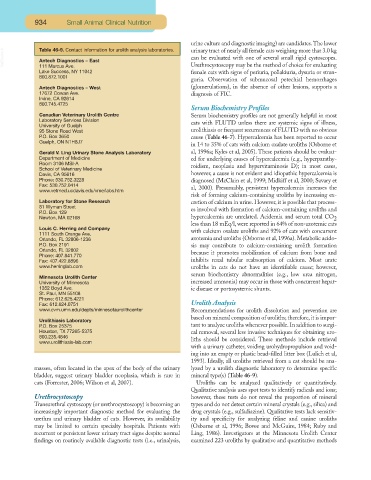Page 902 - Small Animal Clinical Nutrition 5th Edition
P. 902
934 Small Animal Clinical Nutrition
urine culture and diagnostic imaging) are candidates.The lower
Table 46-9. Contact information for urolith analysis laboratories.
VetBooks.ir Antech Diagnostics – East urinary tract of nearly all female cats weighing more that 3.0 kg
can be evaluated with one of several small rigid cystoscopes.
111 Marcus Ave.
Lake Success, NY 11042 Urethrocystoscopy may be the method of choice for evaluating
female cats with signs of periuria, pollakiuria, dysuria or stran-
800.872.1001
guria. Observation of submucosal petechial hemorrhages
Antech Diagnostics – West (glomerulations), in the absence of other lesions, supports a
17672 Cowan Ave. diagnosis of FIC.
Irvine, CA 92614
800.745.4725
Serum Biochemistry Profiles
Canadian Veterinary Urolith Centre Serum biochemistry profiles are not generally helpful in most
Laboratory Services Division
University of Guelph cats with FLUTD unless there are systemic signs of illness,
95 Stone Road West urolithiasis or frequent recurrences of FLUTD with no obvious
P.O. Box 3650 cause (Table 46-7). Hypercalcemia has been reported to occur
Guelph, ON N1H8J7
in 14 to 35% of cats with calcium oxalate uroliths (Osborne et
Gerald V. Ling Urinary Stone Analysis Laboratory al, 1996a; Kyles et al, 2005). These patients should be evaluat-
Department of Medicine ed for underlying causes of hypercalcemia (e.g., hyperparathy-
Room 3106 MSI-A
School of Veterinary Medicine roidism, neoplasia and hypervitaminosis D); in most cases,
Davis, CA 95616 however, a cause is not evident and idiopathic hypercalcemia is
Phone: 530.752.3228 diagnosed (McClain et al, 1999; Midkiff et al, 2000; Savary et
Fax: 530.752.0414
www.vetmed.ucdavis.edu/vme/labs.htm al, 2000). Presumably, persistent hypercalcemia increases the
risk of forming calcium-containing uroliths by increasing ex-
Laboratory for Stone Research cretion of calcium in urine. However, it is possible that process-
81 Wyman Street
P.O. Box 129 es involved with formation of calcium-containing uroliths and
Newton, MA 02168 hypercalcemia are unrelated. Acidemia and serum total CO 2
less than 18 mEq/l, were reported in 64% of non-azotemic cats
Louis C. Herring and Company
1111 South Orange Ave. with calcium oxalate uroliths and 92% of cats with concurrent
Orlando, FL 32806-1236 azotemia and uroliths (Osborne et al, 1996a). Metabolic acido-
P.O. Box 2191 sis may contribute to calcium-containing urolith formation
Orlando, FL 32802
Phone: 407.841.770 because it promotes mobilization of calcium from bone and
Fax: 407.422.8896 inhibits renal tubular reabsorption of calcium. Most urate
www.herringlab.com uroliths in cats do not have an identifiable cause; however,
serum biochemistry abnormalities (e.g., low urea nitrogen,
Minnesota Urolith Center
University of Minnesota increased ammonia) may occur in those with concurrent hepat-
1352 Boyd Ave. ic disease or portosystemic shunts.
St. Paul, MN 55108
Phone: 612.625.4221
Fax: 612.624.0751 Urolith Analysis
www.cvm.umn.edu/depts/minnesotaurolithcenter Recommendations for urolith dissolution and prevention are
based on mineral composition of uroliths; therefore, it is impor-
Urolithiasis Laboratory
P.O. Box 25375 tant to analyze uroliths whenever possible. In addition to surgi-
Houston, TX 77265-5375 cal removal, several less invasive techniques for obtaining uro-
800.235.4846
www.urolithiasis-lab.com liths should be considered. These methods include retrieval
with a urinary catheter, voiding urohydropropulsion and void-
ing into an empty or plastic bead-filled litter box (Lulich et al,
1993). Ideally, all uroliths retrieved from a cat should be ana-
masses, often located in the apex of the body of the urinary lyzed by a urolith diagnostic laboratory to determine specific
bladder, suggest urinary bladder neoplasia, which is rare in mineral type(s) (Table 46-9).
cats (Forrester, 2006; Wilson et al, 2007). Uroliths can be analyzed qualitatively or quantitatively.
Qualitative analysis uses spot tests to identify radicals and ions;
Urethrocystoscopy however, these tests do not reveal the proportion of mineral
Transurethral cystoscopy (or urethrocystoscopy) is becoming an types and do not detect certain mineral crystals (e.g., silica) and
increasingly important diagnostic method for evaluating the drug crystals (e.g., sulfadiazine). Qualitative tests lack sensitiv-
urethra and urinary bladder of cats. However, its availability ity and specificity for analyzing feline and canine uroliths
may be limited to certain specialty hospitals. Patients with (Osborne et al, 1996; Bovee and McGuire, 1984; Ruby and
recurrent or persistent lower urinary tract signs despite normal Ling, 1986). Investigators at the Minnesota Urolith Center
findings on routinely available diagnostic tests (i.e., urinalysis, examined 223 uroliths by qualitative and quantitative methods

